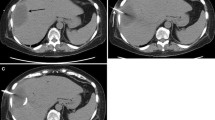Abstract
PURPOSE: This study was designed to assess the efficacy of computed tomography-guided percutaneous abscess drainage in intestinal disease. METHODS: Retrospective chart review of patients who underwent percutaneous abscess drainage for complications of intestinal disease with or without surgery between 1990 and 1994. RESULTS: Eighty-two patients with 111 abscesses were identified. Causes of abscess included anastomotic leaks (35 percent), postoperative complications without leak (30 percent), and diverticular disease (23 percent). Complete success (no surgery necessary) was achieved in 53 of 82 patients (65 percent). Nine patients (11 percent) who underwent interval surgery were classified as having partial successes. Twenty-six of 26 (100 percent) well-defined unilocular collections containing pus were successfully drained. Complex abscesses (loculated, poorly defined, multiple, associated with fistula, draining feces) were successfully drained in 35 of 55 patients (63 percent). Success rates varied inversely with the number of complicating factors present. Apache II scores of 15 or higher were associated with decreased success rates. CONCLUSION: Percutaneous abscess drainage is a highly successful technique for treatment of patients with intra-abdominal infection related to intestinal disease. Although several factors are associated with decreased success rates and multiple complicating factors combine to reduce success rates, no identifiable factor or combination of factors preclude the possibility of a successful outcome.
Similar content being viewed by others
References
Gerzof SG, Robbins AH, Johnsn WC,et al. Percutaneous catheter drainage of abdominal abscesses: a five year experience. N Engl J Med 1981;305:653–7.
van Sonnenberg E, Mueller PR, Ferrucci JT Jr. Percutaneous drainage of 250 abdominal abscesses and fluid collections. Radiology 1984;151:337–41.
Olak J, Christou NV, Stein LA, Casola G, Meakins JL. Operative vs. percutaneous drainage of intra-abdominal abscesses. Arch Surg 1986;121:141–6.
Stabile BE, Puccio E, Van Sonnenberg E, Neff CC. Preoperative percutaneous drainage of diverticular abscesses. Am J Surg 1990;159:99–105.
Gerzof SG, Johnson WC, Robbins AH, Nabseth DC. Expanded criteria for percutaneous abscess drainage. Arch Surg 1985;120:227–32.
Jaques P, Mauro M, Safrit H, Yankaskas B, Piggott B. CT features of intra-abdominal abscesses: prediction of successful percutaneous drainage. AJR Am J Roentgenol 1986;146:1041–5.
Lambiase RE, Cronan JJ, Dorfman GS, Paolella LP, Haas RA. Postoperative abscesses with enteric communication: percutaneous treatment. Radiology 1989;171:497–500.
Kerlan RK, Jeffrey BR Jr, Pogany AC, Ring EJ. Abdominal abscesses with low output fistula: successful percutaneous drainage. Radiology 1985;155:73–5.
Lieberman RP, Hahn FJ, Imray TJ, Phalen JT. Loculated abscesses: management by percutaneous fracture of septations. Radiology 1986;161:827–8.
Pruett TL, Simmons RI. Status of percutaneous catheter drainage of abscesses. Surg Clin North Am 1988;68:89–105.
Knaus WA, Draper EA, Wagner DP,et al. APACHE II: a severity of disease classification system. Crit Care Med 1985;33:818–29.
Knaus WA, Draper EA, Wagner DP,et al. An evaluation of outcome from intensive care in major medical centers. Ann Intern Med 1986;104:410–8.
Fry DE, Garrison N, Heitsch RC, Calhoun K, Polk HC. Determinants of death in patients with intraabdominal abscesses. Surgery 1980;88:517–23.
Lurie K, Pizak L, Deveney CW. Intro-abdominal abscess in the 1980's. Surg Clin North Am 1987;67:621–32.
Pruett TL, Rotstein OD, Crass J, Frick MP, Flohr A, Simmons RL. Percutaneous aspiration and drainage for suspected abdominal infection. Surgery 1984;96:731–7.
Haaga JR. Imaging intraabdominal abscesses and non-operative drainage procedures. World J Surg 1990;14:204–9.
Saini S, Kellum JM, O'Leary MP,et al. Improved localization and survival in patients with intraabdominal abscesses. Am J Surg 1983;145:136–42.
Dondelinger RF, De Baets P, Kurdziel JC. Percutaneous aspiration and drainage of abdominal abscesses under x-ray computed tomography control: prospective study of 63 cases. Ann Radiol (Paris) 1987;30:373–85.
Goletti O, Lippolis PV, Chiarugi M,et al. Percutaneous ultrasound-guided drainage of intraabdominal abscesses. Br J Surg 1993;80:336–9.
Author information
Authors and Affiliations
Additional information
Read at the meeting of The American Society of Colon and Rectal Surgeons, Montreal, Quebec, Canada, May 7 to 12, 1995.
About this article
Cite this article
Bernini, A., Spencer, M.P., Wong, W.D. et al. Computed tomography-guided percutaneous abscess drainage in intestinal disease. Dis Colon Rectum 40, 1009–1013 (1997). https://doi.org/10.1007/BF02050920
Issue Date:
DOI: https://doi.org/10.1007/BF02050920




